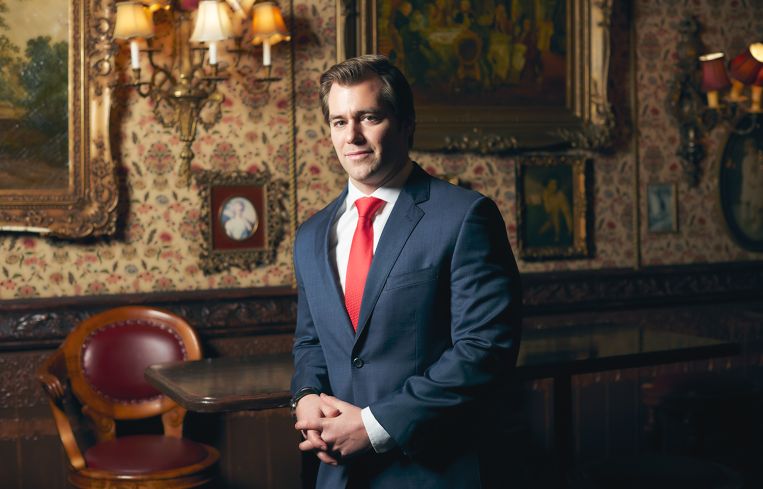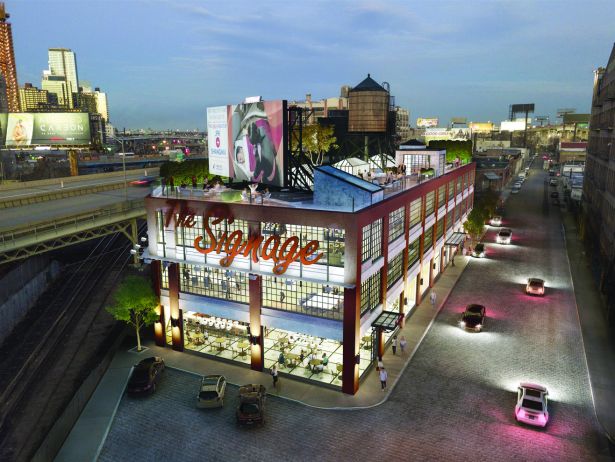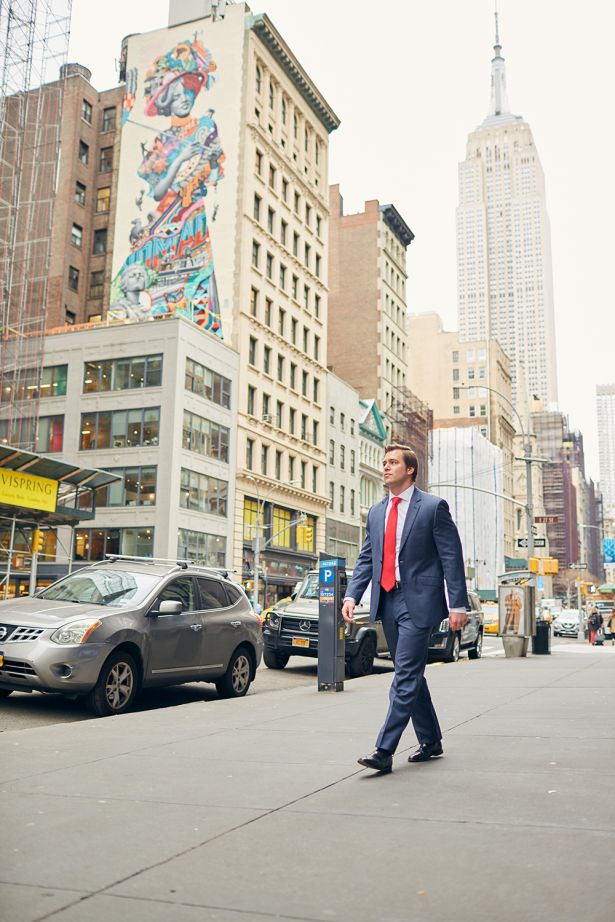Kaufman’s Mike Kazmierski on Midtown South and the Firm’s Investment Future
By Mack Burke March 18, 2020 10:00 am
reprints
It’s not that Michael Kazmierski doesn’t like change; he just enjoys stability and fluidity.
The 36-year-old president and principal of Kaufman Investments (formerly Kaufman New Ventures), the investment arm of the 110-year-old Kaufman Organization, still lives in the same Hell’s Kitchen walk-up he rented when he got his start in New York as a financial analyst in 2011.
Kazmierski is humble and sports a thick Michigan-ized Midwestern accent. The Detroit native earned both a bachelor’s and a master’s degree in finance at Bentley University in Waltham, Mass. He was also recruited to play Division I hockey as a defenseman for the university (his two front teeth are fake — he lost the originals after taking a stick to the face in practice — “wear your mouthguard!” he says). Following his tenure at Bentley, he moved east to Cambridge, Mass., to begin a master’s program in real estate development at the Massachusetts Institute of Technology. His thesis was a couple hundred pages long and focused on real estate entrepreneurs.
Since he was in high school, he’s had a passion for real estate. Previously, he worked for HFF (now part of JLL) at Rockefeller Center and was the last one in the office as Hurricane Sandy approached, dedicated to a deal he was working on that involved Culver City Studios in California.
“Things were flying by all over the place and I’m sitting in the office,” he said.
Last summer, Kazmierski, who was named one of Commercial Observer’s Rising Stars in 2018, took the helm of Kaufman Investments from its former head, Frederic Leffel, who had recruited Kazmierski to be “just a numbers guy” in 2013.
Since joining, he’s had a hand in more than $1.5 billion in office acquisitions, dispositions and finance transactions in the city, mostly focused on office in Midtown South — an area Kaufman is known to dominate.
Last November, Kazmierski led the closing, alongside joint venture partner French insurance firm AXA, of his first marketed deal with Kaufman. The pair picked up 40 West 25th Street for more than $120 million from Japanese firm Unizo Holdings, closing the deal in four weeks, Kazmierski said. It was one of Unizo’s last buildings in the city.
In early February (which feels like a lifetime ago — hence the breezy mention of Airbnb without urgent coronavirus follow-up), Kazmierski sat down with Commercial Observer inside Oscar Wilde, a throwback bar and restaurant sporting an early 20th century theme at the base of a Kaufman’s 45 West 27th Street in NoMad, to chat about his new role, Kaufman’s investment strategy and his love for all things Midtown South.
Commercial Observer: Was the end goal always to get into real estate?
Michael Kazmierski: I started really building an entrepreneurial passion in high school. I was always trying to do things on my own. As a kid, I had my own lawn-cutting business, which worked out pretty well, and I also was just trying out all these weird, entrepreneurial opportunities. Strangely enough, one of them happened to be selling Cub Scout candy. But what drove me to real estate was that I had this buddy in high school who knew a lot of entertainers and they wanted a place to stay and they kind of wanted something beyond what was available, so I had this idea to buy a big mansion. It was: Buy this beast of a mansion and just put them there and rent it out to them.
So you were sort of tapping into the Airbnb concept before Airbnb was a thing?
I’m not going to take any credit and say I had the idea for Airbnb. I was just buying a physical space to rent. I put in an offer, and I had to start learning some basic stuff about real estate. The mansion was in West Bloomfield, [Michigan]. I had to figure out a purchase and sale agreement; the thing was like $7.5 million. Somehow this real estate idea evolved and made me really think about real estate and get excited about it. It didn’t happen, but it was going through the process that got me really excited about physical bricks and sticks. Ever since then, I’ve had this unbridled passion for real estate. I didn’t have a mentor or anything, so I didn’t know what I was doing. Then I got into the MIT program, which was a big game-changer for me. I graduated and I tried to do my own thing for about a year. That was around 2008, and 2009 didn’t work out so well. I didn’t really have any money, so I didn’t have any money to lose at the time.
Where did that put you?
Well, I ended up getting a job in bankruptcy restructuring. I didn’t really have any money and I needed a job. I reached out to every alum from MIT — literally the whole spreadsheet. I got [in touch with] this one guy with a company in Chicago, paid $600 and flew out there. He shows me all these great projects, and I’m like, “Oh, this is awesome. This is my dream to be a real estate developer.” And he said, “It’s 2009, we’re firing everybody, but we have an office in Boston. I’m not exactly sure what they do, but I’ll set up a meeting for you.”
I joined that firm and started doing corporate, bankruptcy restructuring and then started trying to bring in some real estate consulting business too. After I joined, I started looking for a job [again], and it took about 18 months [when] the opportunity at HFF [in New York] just happened.
Tell us about your role at Kaufman.
The position has fluidly changed over time. I think one of the things that we’ve built an expertise in is creating newly formed ground leases. We did a ground lease with Gary Barnett at one of the former Ring Buildings. We hadn’t done ground leases before and that resulted in us really learning how to handle them. It was 2014 when we did the first four [of the buildings in the Ring portfolio] and then 2015 was the fifth with Gary. We were never really looking to do ground leases, but it was a great opportunity and so we did it. And by doing that, we shifted our strategy a little bit. We have these multi-generational family relationships, and we talked to everyone and found it as a solution for [them].
How has the ground lease aspect grown since you’ve been there?
We’ve done eight in the last five years and we’re closing soon on the ninth. No one’s done more — that I’m aware of — in New York City, at least in this last five-year period. It’s something that’s resonated with us. [You and I are] at 45 West 27th Street, and I have four buildings between Fifth and Sixth [Avenues] that are all on ground leases. We have 119 West 25th Street that’s a ground these; 155 West 23rd Street is a ground lease; and 19 West 24th Street is a ground lease. So, when you have one of these family members, you can just kind of walk them through and say, “Hey, here are the results of what we did. Here’s what your building looks like now and here’s what it will look like after.” We’re kind of being a steward and a shepherd for their wealth preservation for the next generation. I think showing something tangible is what resonates, versus leasing it for a long period and just assuring them it will look good.

What Kaufman asset are you most excited about?
It’s effectively done, but we’re still in lease-up mode; it’s called [the Cardinal Building at] 21-01 51st Avenue in LIC, off the Hunters Point 7 train. We’re taking the existing building and transforming it [to office]; [it’s about] 65,000 square feet. But it was so cool what we did, given its history. It was an old toy manufacturing building, and we did it under a ground lease with a family’s investment. We dropped the window line by two-and-a-half feet and took the elevator to the roof. We completely transformed the entire building, which probably makes it the most exciting for me.
Do you think the older product Kaufman often works with is more charming and appealing than the prototypical stuff?
I think a lot of people appreciate authenticity. I mean, [45 West 27th Street] is a perfect example. This building was built in, like, 1912. These are the original floors [inside Oscar Wilde], from what I understand, which people were standing on 100 years ago. And this building, when we bought it five years ago, was completely in disrepair and was 100 percent vacant and falling apart. We upgraded this building to accommodate all the technological needs and advances that Midtown South tenants want — like tech tenants and media tenants. Here you have a cocktail restaurant concept, with a theme that’s 1900, which is the time when this building was built and so you’re going full circle. What they’ve done is embrace this authentic feel of a time in the past, and I don’t think that’s dissimilar to what Kaufman has done. We really embrace the past and what we’ve learned from it.
What’s the focus of the new investments division under your leadership?
Kaufman Investments basically handles all new investments going forward in a traditional GP, LP structure — an operator and an institutional capital partner. That’s how this platform works. We’ve had a variety of institutional capital partners, like Principal Life, Goldman Sachs, China Orient Asset Management and we just closed the deal with AXA, a French insurance company. We’re office guys, and we stick with our core competencies, at the end of the day, and that’s value-add office, really, with a heavy focus in Manhattan, specifically Midtown South. So I think in this type of environment, where it’s so competitive and people are so well-capitalized, having a focus is key. If you want to compete, you have to be the best at what you do. We’ve been exploring a ground-up boutique office in Midtown South, [which will be our 12th property since I joined].

What is it about Midtown South? Why has that been such a focus for Kaufman?
They have two buildings there that they’ve had for maybe 70 or 80 years. But real estate for us is not a commodity. It’s not like a bet on New York or on office. It’s much more strategic, nuanced and granular, where we look at things block-by-block and building-by-building and micro-market by micro-market. What we’ve found is that this market in particular has really resonated with tenants. It’s one of the few micro-markets in Manhattan that we’ve seen a significant evolution over the last five to 10 years. Many of these B buildings, over time, have been converted to residential. So, you’re constraining supply. The demand has really changed and the type of tenants that have been consuming office space has changed. It’s not just tech tenants. The people who want to be here are the people that can afford to be here, and they want to be in a really highly desirable area. What’s happened over the last 10 years is the convergence of the reduction supply, which puts an increase in density. When you increase the density, you also have additional retail amenities, like restaurants and bars in an area where public transportation is phenomenal. So it’s evolved into this 24-hour market. We continue to see the demand here. I’ve got to tell you, we’re just very optimistic about what’s going on here, because the evolution continues. The demand was from 14th to 23rd Street — Midtown South proper, I’ll call it — but over the last five years, it pushed through 23rd Street. We bought another seven [assets] or something like that because we just saw the demand continue to push north.
How has Kaufman’s investment appetite shifted over the years, taking into account the long-term-hold investment philosophy of the company?
Back in the day, before my time, they did a lot of co-op conversions, and it was a big part of the business back then. But [the office portfolio] really speaks for itself. I think that’s kind of how it evolved. We have our hands full with what we know, and then, sometimes once in a while, something special comes along that’s a little different than we typically do. One of those things now is ground-up office [development]. We haven’t closed one yet, but we have a very strong comfort there now. We’re hoping to find that opportunity, if it exists. That’s a little different than the traditional business model we’ve had.
We’ve been very optimistic on smaller floor plates — 5,000 to 15,000 or 20,000 square feet. [Most of] the new office construction [in the city] have average floor plates in excess of 20,000 square feet. So when we look at stuff that’s 20,000 square feet and lower, particularly with the emergence of these high-growth industry tenants — in media, tech, education and health care, for example — these guys are out here looking for 5,000 to 15,000 square feet. That type of floor plate in the right buildings presents a tremendous amount of liquidity and demand. There are buildings of that type of floor plate in Midtown South and Midtown East.
Why do you think you have so much success in off-market transactions, and why is that where you mostly live?
I think it just comes down to a proactiveness and hustle and really staying on top of owners, and trying to build those relationships directly, so that when they’re looking to do something, you know about it and you can act on it. It’s really an information business, because if these guys are going to do something off-market, it’s all about timing, and you better hope you’ve built the relationship already otherwise you’re going to be behind the game. Those have been critical components to success in doing off-market deals.



